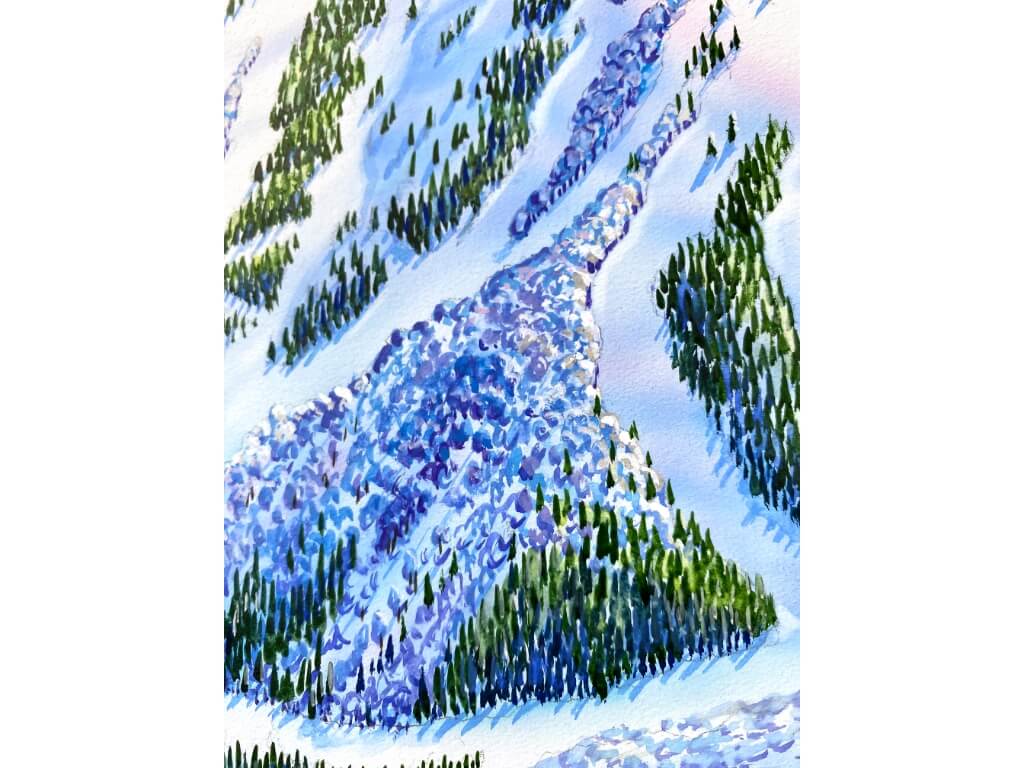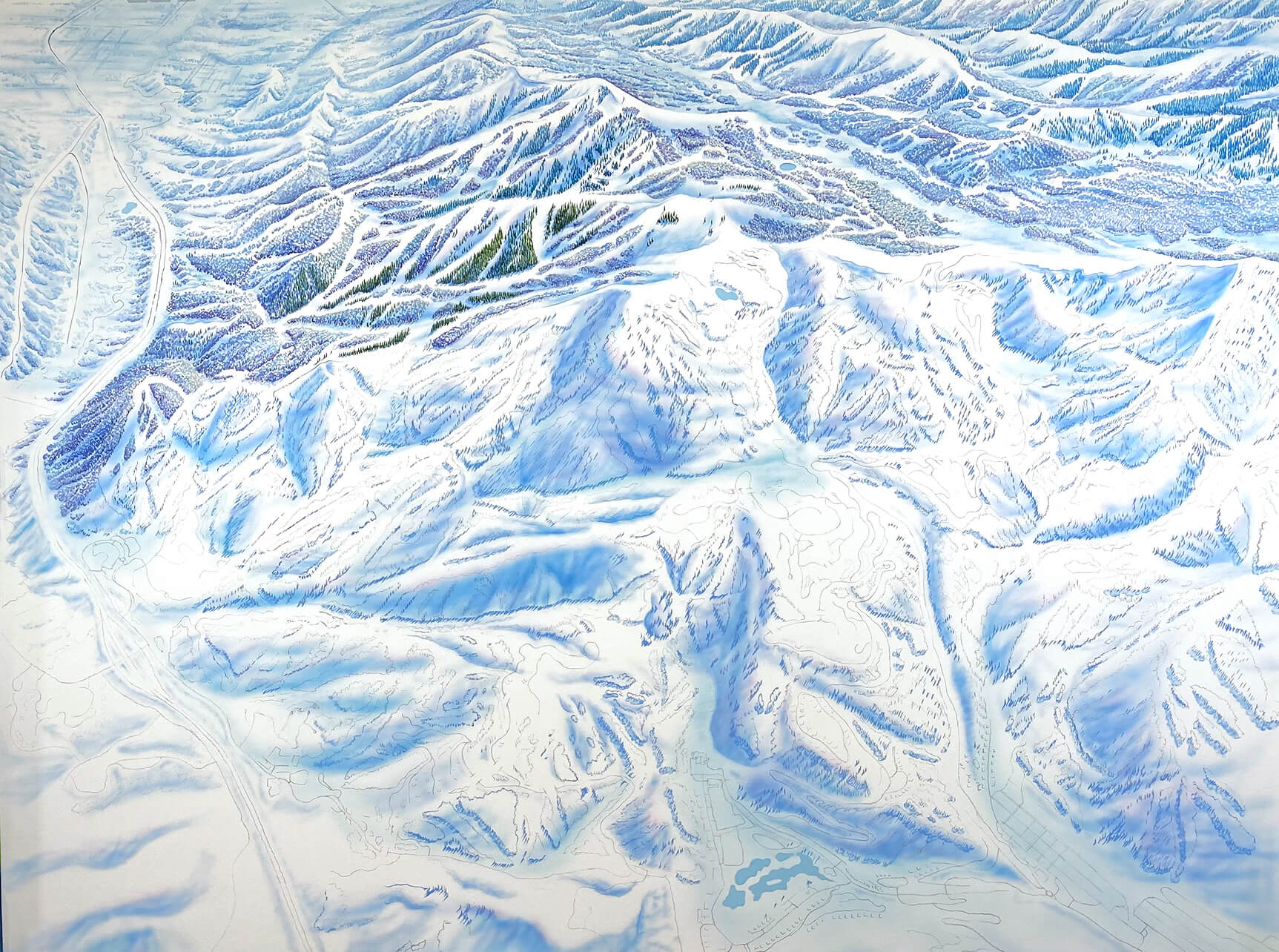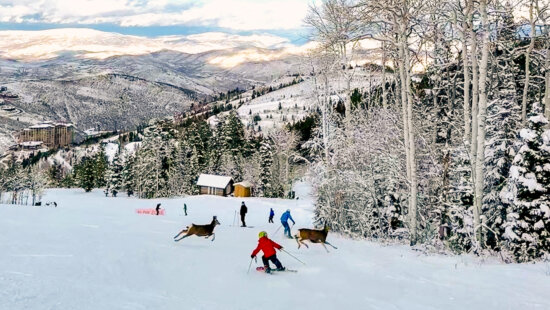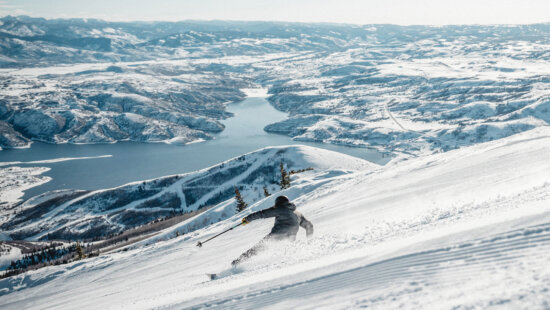Editor’s Picks
Mapping the mountain by hand: The art and craft of Rad Smith’s Deer Valley vision

Artist Rad Smith in his Montana studio with one of his hand-painted maps. Smith, who trained under legendary ski map artist James Niehues, continues the 60-year tradition of crafting detailed, hand-rendered trail maps that blend art, geography, and mountain culture. Photo: Rad Smith
PARK CITY, Utah — For ski map artist Rad Smith, everything begins from an aerial perspective, revealing how terrain folds, stretches, and shimmers across the earth.

“I’ve always loved maps,” Smith said. “Even when I was working as a graphic designer and illustrator, everything seemed to revolve around some form of mapping. I adored the appearance of a National Geographic map, with its hill shading and depiction of the earth’s textures. I grew up looking at that material, and I kept coming back to it.”
Smith’s journey to becoming one of the country’s few hand-painted ski map artists was not straightforward. After studying fine art and commercial design, he spent years in related fields, including art direction for Spyder Outerwear in Colorado and illustration and environmental graphics for consulting firms in Montana. However, as the years passed, he found himself yearning for the tactile world of art that he originally loved: “I had spent decades looking at a computer, drawing digitally, and I was really getting tired of it. I still loved to draw and paint whenever I went camping or spent time with my daughters. I wanted more of that in my professional life.”
In the early 2000s, Smith began creating digital maps for Big Sky and Moonlight Basin. Around that time, he discovered the work of legendary ski map painter James Niehues, whose brushwork defined the visual language of the modern ski world. “When I realized he was the same person painting all these maps, from Rocky Mountain National Park to ski resorts, I kind of fell in love with that style and the tradition of hand-painted maps,” Smith said.
When Niehues mentioned retirement in a few interviews, Smith reached out to him. “I just wanted to start a conversation,” he recalled. “He was very encouraging, excited that I was interested. He suggested I take one of my digital maps and try painting it. That’s really where it started.” This experimentation led to commissions, and soon after, Niehues began referring Smith’s name to various resorts.
By 2021, Smith decided to step away from his long-time design firm and dedicate himself fully to painted maps. “Every year since then, it’s grown. It’s about 90 percent of my work now.”

A Legacy Passed Down
Smith is humble about stepping into a lineage that includes Hal Shelton, Bill Brown, and Niehues—a legacy spanning over six decades. “It’s daunting to look at their work and try to reach that level,” he admitted. “Someone once told me, ‘Not only are James’s shoes huge to fill, but really, nobody can fill them.’ His proficiency and the impact he’s had, it’s incredible. So I try to take it project by project.”
Niehues encouraged him to find his own style. “James has been clear that I should pursue my own look and feel. Bill Brown told him the same thing. Early in his career, James tried to replicate Bill’s aesthetic until Bill advised him to make it his own. I’m trying to do that, too. There’s a traditional look and feel that runs through all our work, that’s what I aim for with each piece.”

Mapping Deer Valley
When Deer Valley Resort reached out to Smith, he immediately recognized that the project would be complex. “From the start, I could tell it would require a different approach,” he said. “It couldn’t be a traditional map with a sky and horizon—there’s just too much depth going north to south.”
To prepare, he studied aerial imagery, used 3D mapping tools sparingly, and relied heavily on drone photos provided by the resort. “Deer Valley was great about sending me imagery and maps, and I had the opportunity to ski and spend a few days on the mountain. That was super helpful. I was able to ski with their staff, including in the new terrain. It gave me a whole different perspective.”
That fieldwork informed a three-stage process: a line draft, a detailed pencil sketch, and finally, the painting itself. “A map that size, about 30 by 40 inches, takes around 150 hours from start to finish,” Smith explained. “The line draft shows the major topographic features, and the pencil sketch adds detail and shading. That alone can take me five or six days of full-time work. Then I project that sketch onto an illustration board and start painting. Each step adds more information and refinement.”
The technical challenge, he noted, lies in balancing clarity and realism. “You sometimes have to manipulate reality—bend the perspective so everything’s visible and labelable. You rely on hill shading and tree shadows to show vertical relief. Otherwise, it looks flat. It’s like solving a big puzzle, layer by layer.”

Art, Accuracy, and the Human Hand
For Smith, a ski map must strike a balance between utility and artistry. “The people who know the ski area best, the patrollers, managers, they help ensure it’s accurate and believable. But at the same time, it is a piece of artwork. I can’t paint every tree or every detail. I’m hard on myself, but that pushes me to create something I want to look at. If I can achieve that, hopefully others will find it enjoyable too.”
He is quick to credit the team effort behind the final map of Deer Valley. “I love that people are excited about the artwork, but I want to be clear—it wasn’t just me who created it.”

Looking Ahead
The Deer Valley project, Smith said, reminded him of what he values most: community. “People who work at ski areas are just wonderful. They’re passionate, and that rubs off. It’s always a positive process. Every project makes me more excited to keep going.”
Next on his easel are maps for Brian Head, Sundance, and another new map for Deer Valley that will showcase the resort’s expanding terrain in a more traditional perspective.
“I hope skiers continue to see the value in a traditional, hand-painted map, especially in this digital age,” Smith said. “There’s something about the human touch. I think human nature draws us back to it. There’s just something enduring about it.”




















